This page contains information on guidance on design and planning guidelines.
Contents:
- Facilities and Design Guidelines
- Bicycle and Pedestrian Planning
- Parking Policies
- Zoning Policies
- Bicycle and Pedestrian Advisory Committees
Facilities and Design Guidelines
A Citizen's Guide to Better Streets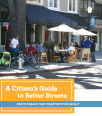 In this 2008 Project for Public Spaces must-read document for anyone interested in transforming streets into great places for everyone, Gary Toth, a former New Jersey Department of Transportation (NJDOT) employee outlines how to establish a productive relationship with your DOT by advocating partnership and collaboration. Toth also explains the technical and regulatory processes that shape how DOTs make decisions and offers advice on how to deal with governmental bureaucracies, transportation planning processes and issues of liability.
In this 2008 Project for Public Spaces must-read document for anyone interested in transforming streets into great places for everyone, Gary Toth, a former New Jersey Department of Transportation (NJDOT) employee outlines how to establish a productive relationship with your DOT by advocating partnership and collaboration. Toth also explains the technical and regulatory processes that shape how DOTs make decisions and offers advice on how to deal with governmental bureaucracies, transportation planning processes and issues of liability.
A Citizen's Guide to Better Streets (PDF, 2.7MB)
Bicycle Facilities and the Manual on Uniform Traffic Control Devices The Federal Highway Administration (FHWA) receives occasional inquiries about what bicycle facilities, signs, and markings are permitted in the Manual on Uniform Traffic Control Devices (MUTCD). This table lists various bicycle-related signs, markings, signals, and other treatments and identifies their status (e.g., can be implemented, currently experimental) in the 2009 version of the MUTCD.
The Federal Highway Administration (FHWA) receives occasional inquiries about what bicycle facilities, signs, and markings are permitted in the Manual on Uniform Traffic Control Devices (MUTCD). This table lists various bicycle-related signs, markings, signals, and other treatments and identifies their status (e.g., can be implemented, currently experimental) in the 2009 version of the MUTCD.
Bicycle Facilities and the Manual on Uniform Traffic Control Devices (URL)
Bike & Pedestrian Facility Design Publications The Federal Highway Administration (FHWA) has several publications about or including bike lanes on the Publications page of its Bicycle and Pedestrian Program website.
The Federal Highway Administration (FHWA) has several publications about or including bike lanes on the Publications page of its Bicycle and Pedestrian Program website.
Bike & Pedestrian Facility Design Publications (URL)
Urban Bikeway Design Guide Launched at the 2011 National Bike Summit, this interactive online document from the National Association of City Transportation Officials provides practitioners in cities and towns around the United States with the state-of-the-practice solutions for on-street bicycle facilities.
Launched at the 2011 National Bike Summit, this interactive online document from the National Association of City Transportation Officials provides practitioners in cities and towns around the United States with the state-of-the-practice solutions for on-street bicycle facilities.
Urban Bikeway Design Guide (URL)
Guide for the Development of Bicycle Facilities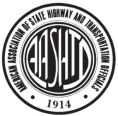 This guide from American Association of State Highway and Transportation Officials (AASHTO) provides information on the development of new facilities to enhance and encourage safe bicycle travel. Planning considerations, design and construction guidelines, and operation and maintenance recommendations are included.
This guide from American Association of State Highway and Transportation Officials (AASHTO) provides information on the development of new facilities to enhance and encourage safe bicycle travel. Planning considerations, design and construction guidelines, and operation and maintenance recommendations are included.
Guide for the Development of Bicycle Facilities (URL)
Bike Boulevard Planning and Design Guidebook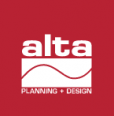 This report from Alta Planning is intended to serve as a planning and conceptual design guide for planners, engineers, citizens, advocates, and decision makers who are considering bicycle boulevards in their community. Data for this guide was developed from literature review, case study interviews, and input from a panel of professional experts.
This report from Alta Planning is intended to serve as a planning and conceptual design guide for planners, engineers, citizens, advocates, and decision makers who are considering bicycle boulevards in their community. Data for this guide was developed from literature review, case study interviews, and input from a panel of professional experts.
Bike Boulevard Planning and Design Guidebook (PDF)
Creating Walkable Communities on a Budget Building interest and engaging the community are key components of successful walking advocacy campaigns. From structured events and community studies to guerrilla marketing campaigns, there are ways to make communities more walkable without breaking the bank. On this Mutual Aid Call held by America Walks and the Alliance for Biking & Walking, panelists Lindsey Ganson, Matt Tomasulo and Lisa Quinn described some of the campaigns they've been working on and shared lessons learned.
Building interest and engaging the community are key components of successful walking advocacy campaigns. From structured events and community studies to guerrilla marketing campaigns, there are ways to make communities more walkable without breaking the bank. On this Mutual Aid Call held by America Walks and the Alliance for Biking & Walking, panelists Lindsey Ganson, Matt Tomasulo and Lisa Quinn described some of the campaigns they've been working on and shared lessons learned.
Creating Walkable Communities Tip Sheet (PDF)
Call recording (MP3)
Guide for Reviewing Public Road Design and Bicycling Accommodations for VA Bicycling Advocates
 This 2010 guide — authored by the Fairfax Advocates for Better Bicycling and funded, in part, by the Alliance's Advocacy Advance Grants program — outlines ways bicycling proponents can get involved in the process of designing, approving, building, and retrofitting roads to ensure that bicycling accommodations are integrated into the plans where needed. The 28-page resource covers the basics of understanding engineering plans, outlines various roadway features and provides checklists to help advocates review and comment on road design plans. Despite its Virginia focus, the guide provides relevant advice and information for bicycle advocates across the country.
This 2010 guide — authored by the Fairfax Advocates for Better Bicycling and funded, in part, by the Alliance's Advocacy Advance Grants program — outlines ways bicycling proponents can get involved in the process of designing, approving, building, and retrofitting roads to ensure that bicycling accommodations are integrated into the plans where needed. The 28-page resource covers the basics of understanding engineering plans, outlines various roadway features and provides checklists to help advocates review and comment on road design plans. Despite its Virginia focus, the guide provides relevant advice and information for bicycle advocates across the country.
Guide for Reviewing Public Road Design and Bicycling Accommodations for Virginia Bicycling Advocates (PDF, 6 MB)
Infrastructure, Programs, and Policies to Increase Bicycling: An international Review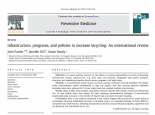 This 2009 report from Dr. John Pucher, Jennifer Dill, and Susan Handy attempts to assess existing research on the effects of various interventions on levels of bicycling. Interventions include infrastructure (e.g., bike lanes and parking), integration with public transport, education and marketing programs, bicycle access programs, and legal issues.
This 2009 report from Dr. John Pucher, Jennifer Dill, and Susan Handy attempts to assess existing research on the effects of various interventions on levels of bicycling. Interventions include infrastructure (e.g., bike lanes and parking), integration with public transport, education and marketing programs, bicycle access programs, and legal issues.
Infrastructure, Programs, and Policies to Increase Bicycling (PDF, 1.5MB)
Bicycle and Pedestrian Planning
The Processes to Improve Your Community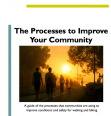 This report from MaineDOT outlines the processes that are being employed to bring improvements to the bicycle and pedestrian infrastructure of Maine's communities.
This report from MaineDOT outlines the processes that are being employed to bring improvements to the bicycle and pedestrian infrastructure of Maine's communities.
MaineDOT Guide (PDF)
Bicycle and Pedestrian Planning Guide (League of Illinois Bicyclists)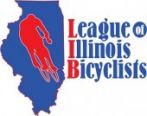 April 12, 2011. A 16-page guide to municipal bicycle and pedestrian planning.
April 12, 2011. A 16-page guide to municipal bicycle and pedestrian planning.
Bicycle and Pedestrian Planning Guide (PDF)
Adding Voices to the Discussion: Engaging Pedestrians in the Planning Process - Mutual Aid Call (Alliance) Especially when it comes to transportation issues, the public process often attracts a small cadre of usual suspects: Those who have a zeal for community activism and an understanding of transportation issues. Often missing is input from pedestrians who don't identify as an interest group, residents who are not comfortable speaking up at meetings, and folks who do not speak English as a first language. But there are emerging models in how to shift this paradigm, including recent work by WalkBoston, which utilized a grant from the Federal Transit Administration to develop and test low cost/low tech tools to engage underrepresented populations. In this call, learn from WalkBoston and other advocates, as we discuss how to add voices to the planning process and engage more pedestrians in these critical issues.
Especially when it comes to transportation issues, the public process often attracts a small cadre of usual suspects: Those who have a zeal for community activism and an understanding of transportation issues. Often missing is input from pedestrians who don't identify as an interest group, residents who are not comfortable speaking up at meetings, and folks who do not speak English as a first language. But there are emerging models in how to shift this paradigm, including recent work by WalkBoston, which utilized a grant from the Federal Transit Administration to develop and test low cost/low tech tools to engage underrepresented populations. In this call, learn from WalkBoston and other advocates, as we discuss how to add voices to the planning process and engage more pedestrians in these critical issues.
Tip Sheet-Engaging Peds in Planning (PDF)
Call recording (MP3)
Sample Bicycle & Pedestrian Plans (Pedestrian & Bicycle Information Center) This list of bicycle and pedestrian plans from the Pedestrian & Bicycle Information Center (PBIC) provides easy access to a number of good examples of bicycle and pedestrian planning at the state, regional, and local levels.
This list of bicycle and pedestrian plans from the Pedestrian & Bicycle Information Center (PBIC) provides easy access to a number of good examples of bicycle and pedestrian planning at the state, regional, and local levels.
Sample Pedestrian and Bicycle Plans (URL)
Getting Involved with Transportation Planning (Public Health Law & Policy) This 2011 fact sheet, created by Public Health Law & Policy in collaboration with TransForm, discusses the important link between transportation planning and health, describes the key players and processes of local and regional transportation planning, and suggests ways to advocate effectively for healthier transportation policies.
This 2011 fact sheet, created by Public Health Law & Policy in collaboration with TransForm, discusses the important link between transportation planning and health, describes the key players and processes of local and regional transportation planning, and suggests ways to advocate effectively for healthier transportation policies.
Getting Involved with Transportation Planning: An Overview for Public Health Advocates (PDF)
Parking
Pricing the Curb: How SF, Chicago and D.C. are Reducing Traffic with Curbside Parking Policy(TA)
 This 2008 report from Transportation Alternatives (TA) outlines how three cities are working to reduce traffic through parking reform.
This 2008 report from Transportation Alternatives (TA) outlines how three cities are working to reduce traffic through parking reform.
Pricing the Curb: How SF, Chicago and D.C. are Reducing Traffic with Curbside Parking Policy (PDF)
Suburbanizing the City Report (Transportation Alternatives)
 This 2008 report from Transportation Alternatives documents how New York City's off-street parking requirements encourage car ownership and use, and contradict policies aimed at reducing traffic.
This 2008 report from Transportation Alternatives documents how New York City's off-street parking requirements encourage car ownership and use, and contradict policies aimed at reducing traffic.
Suburbanizing the City Report (PDF)
Zoning Policies
GreenTRIP GreenTRIP is the Traffic Reduction and Innovative Parking certification program for new residential and mixed use developments. Offered by TransForm, advocacy organization based in California, it expands the definition of green building to include accessibility impacts and rewards projects that reduce traffic and greenhouse gas emissions.
GreenTRIP is the Traffic Reduction and Innovative Parking certification program for new residential and mixed use developments. Offered by TransForm, advocacy organization based in California, it expands the definition of green building to include accessibility impacts and rewards projects that reduce traffic and greenhouse gas emissions.
GreenTRIP (URL)
Bicycle and Pedestrian Advisory Committees
Best Practices for Bicycle and Pedestrian Advisory Committees (Advocacy Advance)
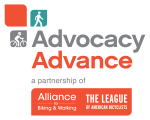 26 August 2012. This report outlines best practices for advocates and agency staff who are looking to establish an effective BPAC in their community, including how to create the group and how to emulate successes of effective BPACs from coast to coast.
26 August 2012. This report outlines best practices for advocates and agency staff who are looking to establish an effective BPAC in their community, including how to create the group and how to emulate successes of effective BPACs from coast to coast.
BPAC Best Practices Report (PDF)
Effective Bike/Ped Advisory Committees- 8/8/2012 (Alliance)
 Bike/ped advisory committees can push better policy decisions, help identify community target areas and generate grassroots support. On our August 8, 2012, Mutual Aid call, panelists Matt Wempe and Molly O'Reilly discussed tips to establish and improve bike/ped advisory committees that reflect the diverse interests of the community and are efficient, effective and institutionalized guides for walk- and bike-friendly policies.
Bike/ped advisory committees can push better policy decisions, help identify community target areas and generate grassroots support. On our August 8, 2012, Mutual Aid call, panelists Matt Wempe and Molly O'Reilly discussed tips to establish and improve bike/ped advisory committees that reflect the diverse interests of the community and are efficient, effective and institutionalized guides for walk- and bike-friendly policies.
Effective Bike/Ped Committees Tip Sheet(PDF)
Call recording(MP3)
Guide to Starting Your Own Bicycle Advisory Committee (MassBike)
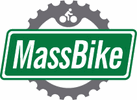 This guide aims to give bicycle advocates the tools needed to successfully push for programmatic, policy, and infrastructure improvements. Another innovative resource MassBike provides on the webpage for this guide is their compiled list of city BACs and contacts.
This guide aims to give bicycle advocates the tools needed to successfully push for programmatic, policy, and infrastructure improvements. Another innovative resource MassBike provides on the webpage for this guide is their compiled list of city BACs and contacts.
Guide to Starting Your BAC; 80 pages (PDF)

